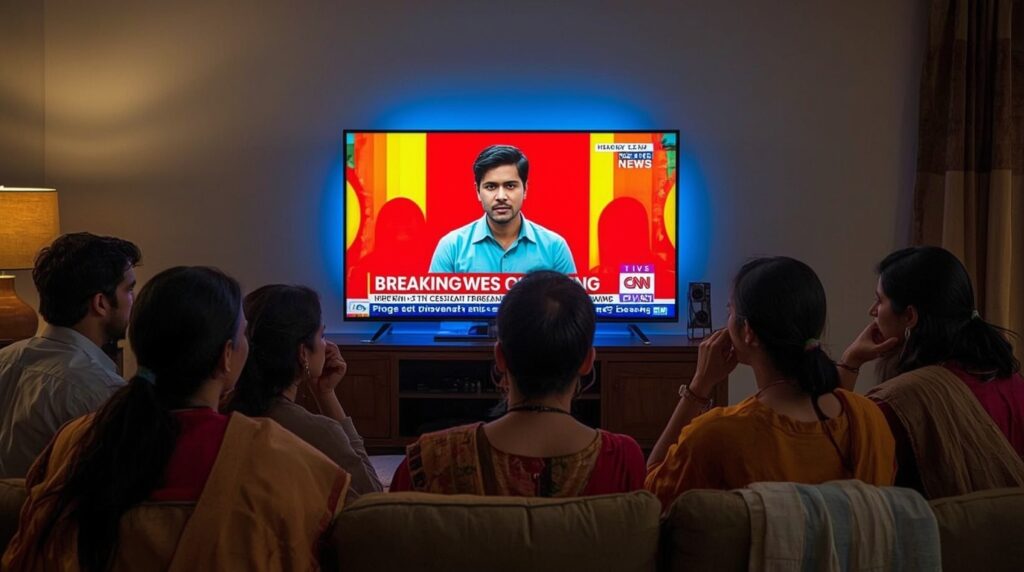A ₹100‑crore TV ratings scam has rocked India’s television industry, exposing flaws in audience measurement and prompting the Ministry of Information & Broadcasting to plan a major overhaul. The alleged collusion between a channel and a BARC employee highlights systemic vulnerabilities, raising urgent questions about transparency, credibility, and the future of broadcast advertising.

Television has long been India’s most enduring source of entertainment, information, and cultural connection. From the first flicker of a family drama in a living room to the roar of cheering fans during cricket matches, Indian households have shaped and been shaped by what appears on their screens. Yet, beneath the bright lights and polished programming, a startling revelation has shaken the very foundation of India’s broadcast industry: a ₹100-crore TV ratings scam that exposes vulnerabilities in how the country measures its audiences and threatens to reshape the industry in profound ways.
The controversy centers around allegations that a Kerala-based television channel and an employee of the Broadcast Audience Research Council (BARC) colluded to manipulate viewership numbers. WhatsApp chats, call logs, and digital evidence suggest that advanced audience data was leaked to the channel in exchange for payments, reportedly routed through crypto wallets. The scheme allegedly inflated the channel’s ratings, allowing it to command higher advertising revenue under false pretenses. While fraud in media measurement is not unheard of globally, the scale, sophistication, and financial magnitude of this case make it a watershed moment for India’s television ecosystem.

Investigators point to a seemingly innocuous metric—“landing-page placement”—as one avenue exploited for manipulation. The channel allegedly claimed that sudden jumps in viewership stemmed from a small cable network in North Kerala, comprising just around 20,000 subscribers. Authorities are now scrutinizing such claims, as evidence points to tampering with PIN codes of neighborhoods hosting BARC meters, enabling the channel to target specific pockets of viewers for artificial boosts. In one striking instance, private numbers shared by the accused matched exactly with official BARC weekly ratings, casting serious doubt on the integrity of the data.
The implications for advertisers, broadcasters, and audiences are significant. Television advertising in India represents a multi-thousand-crore ecosystem, heavily dependent on reliable ratings for determining ad pricing and campaign strategy. When numbers are artificially inflated, advertisers risk investing in channels or programs based on misleading information, undermining both financial and strategic planning. For regional channels, where margins are already thin, even minor discrepancies in reported viewership can translate into substantial revenue loss or gain, making such manipulation particularly tempting.
BARC, which has been the linchpin of television ratings in India for over a decade, now faces an existential test. Founded in 2010 to provide a standardized system for measuring viewership across the country, BARC manages data for over 210 million households and nearly 900 million viewers. Despite the scale, critics have long questioned the system’s representativeness, noting that its roughly 50,000-panel-home sample may not capture the vast diversity of Indian television consumption. This scandal amplifies those concerns and highlights systemic vulnerabilities in data collection, oversight, and governance.
In response, the Ministry of Information & Broadcasting (MIB) has accelerated plans for a fundamental reset of India’s audience measurement framework. Proposed reforms include expanding the rating panel from 50,000 to 120,000 households, allowing multiple accredited measurement agencies to operate alongside BARC, and instituting stricter conflict-of-interest regulations to prevent broadcasters from influencing the agencies tasked with monitoring them. Notably, the draft policy also calls for abolishing “landing-page viewership” metrics, which have been criticized for enabling manipulation.
Industry analysts suggest that the scandal could serve as a catalyst for overdue change. For years, advertisers and competitors have expressed skepticism over the opacity and susceptibility of India’s television ratings system. The ₹100-crore fraud lays bare the ease with which data can be exploited, intensifying calls for a more transparent, accountable, and technologically robust framework. By implementing these reforms, the industry has the opportunity to restore trust, safeguard revenue streams, and ensure that content decisions reflect genuine audience engagement rather than manufactured numbers.
The human dimension of the scandal is equally compelling. Television ratings influence what content is commissioned, which programs survive or fail, and even how media narratives are shaped. When the metrics guiding these decisions are compromised, the consequences ripple far beyond finance, affecting creativity, culture, and the stories reaching millions of households. A manipulated rating doesn’t just mislead advertisers—it can distort the cultural and informational landscape of an entire nation.
Investigations into the case are ongoing. Authorities are meticulously tracing financial transactions, analyzing communication records, and verifying panel data. The channel owner and the BARC employee are under intense scrutiny, with officials emphasizing the need for a thorough, transparent inquiry to restore faith in the system. The outcome of this investigation will likely influence not only regulatory policy but also the standards of accountability and integrity expected in India’s media sector for years to come.
Beyond the immediate scandal, the situation has sparked a broader discussion about the future of television in India. Digital streaming platforms, on-demand content, and social media consumption are increasingly drawing attention and ad revenue away from traditional linear TV. If legacy broadcasters cannot guarantee reliable metrics, their competitive position may weaken further. Audience trust, already a critical commodity in an era of media choice, could erode even more if stakeholders perceive television ratings as unreliable or corruptible.
Yet, the controversy also offers a unique opportunity. By embracing reform and strengthening measurement systems, Indian television can emerge more resilient, credible, and technologically advanced. Expanding the panel, permitting multiple agencies, and enforcing transparency will not only prevent future manipulation but also enhance the accuracy of audience insights, benefiting advertisers, broadcasters, and viewers alike. A transparent system can underpin creativity and investment, ensuring that content decisions reflect real preferences rather than fabricated numbers.
The scandal underscores the fragile architecture underpinning the seemingly simple notion of a “rating point.” Behind each number lies a complex network of data collection, statistical analysis, and ethical oversight. When even a fraction of that network is compromised, the consequences reverberate across the entire media landscape. This episode serves as a cautionary tale of how technological sophistication, human ambition, and insufficient oversight can converge to create systemic vulnerability.
For media professionals, the stakes are personal as well as institutional. Ratings influence career trajectories, creative choices, and professional credibility. When data is falsified, the ripple effect touches writers, directors, producers, and on-screen talent, shaping the entertainment that reaches millions of viewers. The integrity of the industry, in essence, is measured not only in financial terms but in trust—the trust of advertisers, audiences, and the broader public.
As India’s television industry confronts the scandal, it is clear that the road ahead will involve both regulatory and cultural shifts. Enforcement of stricter standards, adoption of technologically robust measurement tools, and cultivation of an ethical ethos will be necessary to prevent recurrence. Equally, industry-wide acknowledgment of the risks and proactive measures to protect the credibility of viewership data will be essential to maintain public confidence.
In the end, this ₹100-crore scam is more than a financial story—it is a wake-up call. It exposes the vulnerabilities of a system many assumed was invulnerable, challenges longstanding assumptions about trust and measurement, and prompts urgent reflection on how India’s television industry can safeguard its integrity in a rapidly evolving media landscape. As the MIB plans its reforms and investigations continue, the hope is that India’s audience measurement system will not only recover from this crisis but emerge stronger, more transparent, and more representative of the billions of viewers it seeks to reflect.
In the colourful, dynamic world of Indian television, the numbers on a screen tell stories every day. But as this scandal reveals, when numbers lie, the stories themselves risk being lost. For an industry that reaches millions of homes and shapes cultural narratives, the imperative is clear: credibility, transparency, and trust are worth far more than even the highest rating.







